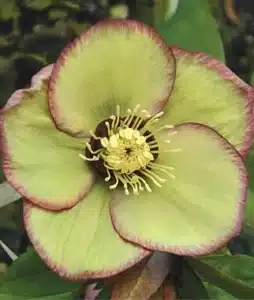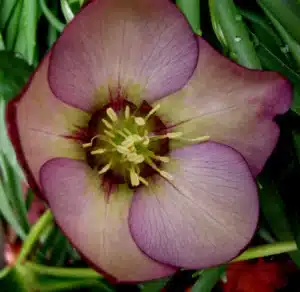Phoenix Hellebore



Botanical Name: Helleborus x hybridus ‘Phoenix’
Plant Family: Ranunculaceae
Category: Perennial
Lifecycle: Perennial
USDA Symbol: HELLE
USDA Zone North: 4A (-30 to -25)
USDA Zone South: 9B (25 to 30)
Sun Requirement: Partial Shade (2-4 hours per day)
Sun Requirement (Alt): Full Shade (little to no direct sun)
Water Requirement: Medium
Growth Rate: Slow
Plant Adult Height: 18-24 in.
Plant Spacing: 18-24 in.
Plant Adult Spread: 18-24 in.
Leaf Shape: Elliptic
Leaf Arrangement: Alternate
Leaf Retention: Evergreen
Flowers: Showy
Flower Time: Winter, Spring
Poisonous: Human Toxic, Pet Toxic
Plant Description:
Reminiscent of a beautiful watercolor, the petals of ‘Phoenix Hellebore’ unfurl in late winter to present softly blending hues of apple green edged with vivid rose-pink or red. To the gardener’s delight, this lovely plant may also exhibit cup-shaped blossoms in exquisite shades of purple, violet, white, lavender, or gold. New garden hybrids, such as ‘Phoenix,’ are cultivated continuously within the category ‘Helleborus x hybridus.’ Presenting a broad spectrum of shades and patterns, these hybrids are most often grouped according to flower color. Many possess exotic markings, such as brightly speckled petals, contrasting margins, or distinctly colored veins. ‘Phoenix’ features abundant nodding blossoms with vibrant yellow stamens in contrast to an elegant backdrop of glossy, evergreen, elliptic or lance shaped leaves with serrated margins. The attractive leaves are palmately divided into segments in an alternate arrangement. The flowers may persist for a period of six months, slowly fading as summer nears to make way for uniquely ornamental and interesting seed heads. Hardy within USDA zones 4-9, the amazing ‘Phoenix’ has been bred to deliver vibrant color from November through April! Frequently referred to by the common name, ‘Lenten Rose,’ hellebores are members of the Buttercup family (Ranunculaceae) and are native to southern Europe. Reaching an average height of 18-24 inches, hellebores deliver dramatic color and texture to the garden at a time of year when few other blooming perennials have yet to emerge. ‘Phoenix’ is most spectacular massed into large groups and should ideally be planted near doorways, windows, patios, or garden pathways where its beauty can be appreciated. The lush, leathery foliage may create a superb groundcover or accompany shade-loving companion plants, such as lush ferns or hosta lilies. It is important to know that hellebore leaves and roots are toxic and must never be ingested by humans or pets. In fact, the botanical name, ‘Hellebore,’ is derived from the Greek terms, “helia,” meaning “to injure,” and “bora,” meaning “food.” ‘Phoenix’ matures slowly and may live for more than 20 years! This easy-to-grow, long-blooming evergreen has become the shining star of the winter garden.
Propagation & Planting:
The ‘Phoenix’ hellebore thrives in evenly moist, loamy, well-drained soil, which has been enriched with compost to improve drainage. Hellebores prefer neutral or alkaline soil with an ideal pH between 7.0 -8.0. The plants are best planted in early fall or late spring in a partially or fully shaded area. The plants should not be exposed to more than 4 hours of direct sunlight daily. Hellebores flourish in woodland gardens or underneath deciduous trees and need to be sheltered from harsh winter winds. Potted plants are available from most reputable nurseries to purchase and transplant into the landscape. However, new plants can easily be propagated from root division. The ideal time to divide mature plants is in spring. A root clump should be dug and divided by gently removing a healthy section of root to replant into its new location. Due to the fact that the ‘Phoenix’ hellebore is a hybrid plant, it cannot be propagated from seed.
Basic Care Instructions:
‘Phoenix’ hellebores thrive in consistently moist soil. It is essential that the soil drains well and never becomes soggy. Plants require about an inch of water per week during dry periods and should not be watered until the surface of the surrounding soil feels dry to the touch. Mature plants are able to tolerate dry conditions. It is beneficial to lay several inches of mulch around the plants for protection from harsh winter cold, but the mulch should be removed before the blooming season.
Fertilizing Instructions:
Hellebores may benefit from a light application of a slow release 10-10-10 fertilizer in early spring, just as new foliage begins to appear. It is helpful to regularly amend the soil with organic matter. Before using fertilizer, it is important to carefully read and follow the directions on the product label.
Pruning Instructions:
To maintain an attractive appearance, all dead or unsightly foliage should be removed in late winter, before the plant begins to bloom. Withering flowers can be cut back to the base of the plant.
Pests & Disease:
Although hellebores are not typically affected by any serious pests, slugs or snails may occasionally show up to munch on the leaves. These can be trapped and removed, or if necessary, treated with diatomaceous earth. Brown patches on the foliage are often caused by Botrytis, a fungus that thrives in cool, wet conditions. The plants may also be affected by other fungal diseases, such as leaf spot or crown rot. Fungicides can be applied early in the growing season to help prevent the occurrence of fungal infections. Proper spacing is important to provide air circulation and prevent diseases from spreading to nearby plants. All fungicides and insecticides must be used only after carefully reading and following the directions on the product label.










